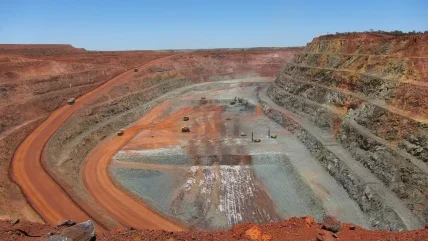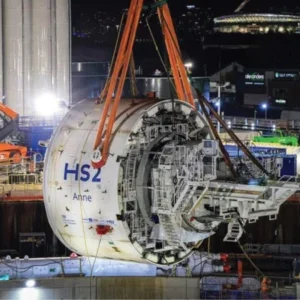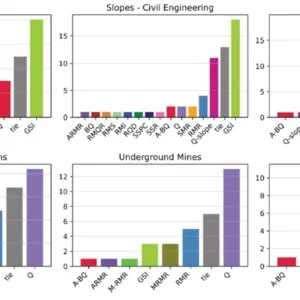
Seequent has published the sixth edition of its ‘Geoprofessionals Data Management Report’, which offers interesting insights in the increasing digital era. Upon its release, chief custom officer, Jo Knight, said: “As civil infrastructure projects become larger, and budgets become tighter, it’s more crucial than ever for organisations to garner greater value from their data.” The report is to highlight “common and emerging challenges amongst the subsurface community, so we can collectively address them.”
The survey data revealed that the mining sector tops the responding geoscience professionals who ranked data management as being of critical/significant importance – 71% of the sample. Of that almost threequarters group, those in the mining sector accounts for 81% and the civils sector brough up the rear, at 55%.
Among the challenges, notes Pat McLarin, segment director (civil), are deficiencies in data management across the civil sector which is behind other sectors. Fewest survey respondents reporting having already established frameworks for data management worked in the civils sector (13%). This is a far cry behind the star performer among the responding geoscience professionals – the mining sector (39%).
However, while civils respondents reported themselves to be least likely to have established systems for data management, they were joint in second place by those in the oil & gas sector as having some kinds of frameworks in place – ‘organised in various systems’ (67%). Only geothermal outdid them (76%) on ‘various systems’, reporting only a mid-rank place (with 19%) on the top tier ‘established’ category.
After mining, the other leading sectors with ‘established’ systems were environmental and government, respectively.
Given those responses, it is a fit that the civils sector respondents reported spending least time, on average, on data management – 22% versus the highest, mining, at 27%.
The civils sector, while lagging, intends to get moving on more established frameworks in the near term (over the coming 12-18 months), according to respondents. Yet, interestingly, quite a number of the civils sector respondents (41%) see themselves as early adopters of new technologies. It may be interesting, here that the sector is the most active in having diverse systems – ‘various systems.’
In an aspect of the latter point, with regard to technological adoption, the respondents had the civil sector sitting fairly middle of the pack with many other subsurface sectors when asked if they were very or somewhat ready to leverage IT such as cloud storage systems – ‘very ready’ (30%), ‘somewhat ready’ (55%. This compares fairly evenly with feedback from the mining sector (26%, 49%).
In fact, the responding civils geoscience professionals reported the sector to be, in total, less (in percentage terms) ‘not ready’ and ‘unsure’ categories compared to all other sectors.
So, civils has less of a consolidated data handling framework but its participants are interested and active – in some of the most ‘varied’ ways.
The sectors most focused and active in readiness to leverage IT cloud systems – being ‘very ready’, according to respondents – were in energy sectors, specifically geothermal (40%) and oil & gas (33%).
And that is the position as all industries and society witnesses an accelerating revolution in data analysis, and more, through machine learning (ML) and artificial intelligence (AI) tools. Interest in ML and AI has jumped in comparison to readiness to leverage the cloud, says Seequent – “bringing a whole new set of questions around best practice and data security.”
While those powerful new systems are tools to digest and parse data for useful insights, the crucial input comes, always, from gathering and holding ever more high quality data. The latest report from Seequent adds, “the pursuit of a single source of truth for all data has never been more intense.”
Further trends – in addition to establishing strong data management frameworks, as discussed – are ongoing issues of concern that include “tracking the chain of custody of data, and managing historical data”.
Interestingly, on types of data, as assessed over the regular intervals when the survey has been performed since 2013, most types show increased importance – such as geological, drill holes or wells, reports & documents, and GIS & imagery. However, geochemical data importance turns out to be relatively flat – or steady – in percentage terms over the six survey periods. One category, though, has progressively dropped in importance each time according to survey respondents – geophysical data.
The share of respondents reporting they don’t have the necessary information for data-driven decisions in their industry sees civils in middling position in a pack (17%) led by mining by a long way (33%). Those reporting the least problem were energy sectors – oil & gas and geothermal at 12% and 9%, respectively.
Use of centralised server storage for holding data is the approach of around half respondents, while almost a fifth still manage their own data, comparable to those using commercial solutions and more than the eighth relaying on internally-developed data storage solutions, according to the survey responses.
* Survey participants were from across the world – North America (46%), South/Central America (20%), UK/Europe (11%), and single digit percentages for New Zealand/Australia, Africa, and Asia, respectively. The survey was done in May, distributed to a randomised sample of Seequent contacts, asked 25 questions, and received a total of 704 responses – most from mining (42%), then civils (17%) and the other sectors.
Among the respondents, job roles were topped by geologists (35%), engineering geologists (18%), geophysicists (16%), data manager/GIS (16%), and geotechnical engineers (14%).






